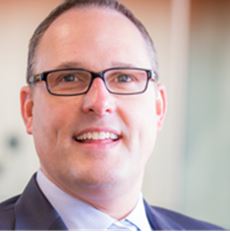The under-diagnosis of and limited treatment options for patients with vertebral compression fractures (VCF) can contribute to poor outcomes among VCF patients, opioid reliance and added cost to the healthcare system. Vertebral compression fractures often occur among adults with osteoporosis and have been a significant public health threat for decades. In 1984, the National Institutes of Health led the Consensus Development Conference on Osteoporosis to examine the condition and scientific evidence around treatment. Out of that conference, the National Osteoporosis Foundation (NOF) was formed with the mission of making a positive impact on patients with osteoporosis.
This content is sponsored by Medtronic.
 “Historically, if a patient with osteoporosis had a vertebral compression fracture, they were recommended bed rest, taking medications and limiting activity,” said Joshua Hirsch, MD, Vice Chair of Interventional Care in the Quality and Safety Service Line; Chief of Interventional Radiology; Division Chief of Neurointerventional Radiology; and Chief of the Interventional Spine Service at Boston-based Massachusetts General Hospital. “Theoretically, physicians told patients, they would get better over time with conservative therapy. If they did, great; if not, they had limited alternatives.”
“Historically, if a patient with osteoporosis had a vertebral compression fracture, they were recommended bed rest, taking medications and limiting activity,” said Joshua Hirsch, MD, Vice Chair of Interventional Care in the Quality and Safety Service Line; Chief of Interventional Radiology; Division Chief of Neurointerventional Radiology; and Chief of the Interventional Spine Service at Boston-based Massachusetts General Hospital. “Theoretically, physicians told patients, they would get better over time with conservative therapy. If they did, great; if not, they had limited alternatives.”
Medical technology companies, including Medtronic, realized there was a significant need for innovation in VCF treatment to relieve the patients’ pain and return them to normal activity. The same year NOF was formed, surgeons performed the first-ever vertebroplasty in France. In the 1990s, the procedure was introduced to the U.S. at Charlottesville-based University of Virginia and since then has become a viable treatment option across the country.
“Putting someone on bed rest, limiting their activities and putting them on medication isn’t good for the rest of their body,” said Dr. Hirsch. “In my practice, we often saw near immediate results with vertebroplasty; there were people who had been hospitalized for an extended period that received the treatment and they would go home the next day. It was one of the most stunning things myself and many other physicians had seen in their practices.”
Medtronic then developed balloon kyphoplasty, a minimally invasive procedure that reduces and stabilizes VCF related to osteoporosis, cancer or benign lesions. Since the initial technology launched, Medtronic has developed better balloons, an improved cement delivery system and added access tools to reduce radiation exposure. Over the years, studies comparing balloon kyphoplasty to non-surgical management have shown balloon kyphoplasty produced better pain relief and quality of life for patients with acute VCF compared to non-surgical management.1,2,3,4 Dr. Hirsch notes that “Balloon Kyphoplasty was a critical next step in the evolution of augmentation procedures.”
For example, one study showed that one week after receiving balloon kyphoplasty, 46 percent of patients reported pain reduction, compared to 15 percent of non-surgical management patients; at one month and two years after treatment, the balloon kyphoplasty patients continued to report significantly better pain relief than non-surgical management.1 Clinical evidence also has shown fewer balloon kyphoplasty patients used pain medications at 12 months and opioids at six months when compared with non-surgical management.1
Additional findings in peer-reviewed clinical studies include, compared to non-surgical management:
• One month after treatment, balloon kyphoplasty patients reported four times greater quality of life improvement than non-surgical management, and balloon kyphoplasty patients continued to maintain significant quality of life improvement two years post treatment.1
• Balloon kyphoplasty patients had higher patient satisfaction two years after treatment.1
The complication rate with Kyphon Balloon Kyphoplasty has been demonstrated to be low. There are risks associated with the procedure (e.g., cement extravasation), including serious complications, and through rare, some of which may be fatal.
Risks of acrylic bone cements include cement leakage, which may cause tissue damage, nerve or circulatory problems, and other serious adverse events, such as: Cardiac arrest, Cerebrovascular accident, Myocardial infarction, Pulmonary embolism and Cardiac embolism.
While Medtronic was busy improving VCF treatment with balloon kyphoplasty and supporting clinical trials, NOF built a campaign for osteoporosis awareness and educating healthcare providers about best treatment practices. In 1990, the organization began publishing the scientific journal Osteoporosis International dedicated to the diagnosis, treatment and management of osteoporosis. The organization also advocated for states to adopt legislation around osteoporosis prevention and treatment education, with success in more than 30 states. NOF published its first clinical guidelines for osteoporosis in 1998 and 10 years later released the “Clinician’s Guide to Prevention and Treatment of Osteoporosis.” NOF became a founding member of the National Bone Health Alliance in 2010, helping to launch a public private partnership to address bone health in the U.S.
With two powerhouse organizations — Medtronic and NOF — running parallel campaigns to address the same problem, it was a matter of time before they pooled resources to really make an impact on VCF diagnosis and treatment in the U.S.
 “We’ve built a really strong partnership with NOF and the National Bone Health Alliance, which has helped extend our message related to osteoporosis for patients that are being diagnosed and not treated through the continuum of care,” said Jeff Cambra, vice president and general manager of Medtronic’s interventional pain therapies – restorative therapies group. “We are trying to build awareness into what VCF is and what options are available to treat that fracture.”
“We’ve built a really strong partnership with NOF and the National Bone Health Alliance, which has helped extend our message related to osteoporosis for patients that are being diagnosed and not treated through the continuum of care,” said Jeff Cambra, vice president and general manager of Medtronic’s interventional pain therapies – restorative therapies group. “We are trying to build awareness into what VCF is and what options are available to treat that fracture.”
The partnership aims to educate clinicians as well as patients about osteoporosis, VCF and available treatment options. One of the biggest opportunities for clinician education is among emergency room staff that see around half a million patients with either hip or vertebral fractures per year.
“We believe that creating a pilot program to provide education to family and ER physicians, starting in eight to 10 cities, could help us understand how to make change,” said Elizabeth Thompson, CEO of NOF. “We want to get the message out as people present to the ER with pain or fractures to get a  complete osteoporosis workup and referral, and if they receive opioids we want to make sure that is really managed. If someone is going back for a refill after two weeks, they should likely have a bone density scan (DEXA) to rule out a vertebral fracture or osteoporosis as the underlying cause.”
complete osteoporosis workup and referral, and if they receive opioids we want to make sure that is really managed. If someone is going back for a refill after two weeks, they should likely have a bone density scan (DEXA) to rule out a vertebral fracture or osteoporosis as the underlying cause.”
Many times, the ER staff refers these patients to orthopedists instead of giving them an osteoporosis work-up and DEXA scan; other times, they prescribe opioids, opening the door for addiction.
“We hope to provide research showing fractures due to osteoporosis isn’t something that can be managed by opioids,” said Claire Gill, chief marketing officer of NOF. “It becomes chronic for patients quickly, and there needs to be further diagnosis of what that pain is for the elder population.”
Eliminating unnecessary treatment and over prescription of opioids has a positive economic impact on the health system and can improve a patient’s quality of life. “We are trying to drive opioid reduction to make sure patients don’t get caught in a downward spiral; we want to make sure they get the care they need earlier,” said Mr. Cambra. “Our goal here is to save dollars within the health system to avoid additional costs associated with patients who incur additional VCF if their initial problems aren’t treated in a timely fashion.”
Some studies have shown that patients who undergo BKP procedures have had a reduction in length of stay. Becker et al., which examined 244 patients treated at a hospital between 2002 and 2005, found the average length of stay among BKP patients was 4.96 days, compared to 5.39 days for non-surgical management patients.5 Chen et al., which examined 68,752 Medicare patients who underwent treatment in 2006, found much greater length of stay among non-surgical patients — 7.38 days — when compared with BKP patients, who reported average length of stay at 3.74 days.6 On the other hand, there were studies that reported slightly extended length of stay for BKP patients. Specifically, Zampini et al., which examined 5,766 patients had 6.0 days with BKP patients when compared to 5.3 days with non-surgical management patients. 8.jpg)
While length of stay is an important metric when choosing a treatment option, the likelihood for an inpatient to be discharged to home is equally important. Chen et al. reported BKP patients had a greater percentage of patients discharged home than the non-surgical management group. 6 Nearly 60 percent of the BKP patients were discharged to home, compared with 23.3 percent of the nonsurgical management patients. The same observation was reported at Ong et al., where 56.9 percent of BKP patients were discharged to home, compared with 33.7 percent of the nonsurgical management patients.8 and at Zampini et al where 38.4% of BKP patients were discharged to home, compared with 21 percent of the non-surgical management patient. 7
Throughout his 20-plus years in practice, Dr. Hirsch has performed hundreds of vertebroplasties and kyphoplasties, seeing how his patients’ lives change after undergoing the procedure. “People who weren’t able to walk are dancing at their child’s wedding,” he said. “They are tending to their gardens and working in the chicken coop. There is no group of procedures more gratifying than vertebral augmentation.”
What’s next for vertebroplasty and balloon kyphoplasty? Medtronic and NOF are strengthening their efforts to target healthcare providers as well as women age 50 and older — the most likely demographic to develop VCF — and educate them about treatment options.
“Healthy women between the age of 50 and 65 years old diagnosed for the first time with osteoporosis don’t necessarily feel sick; they aren’t in pain,” said Ms. Thompson. “But they do want to find resources and support, a community of people who can help them, and they aren’t only interested in their own health, but the health of their family. Women are providing care for themselves, their partner or spouse and aging parents. We are educating this army in addition to family practice and local community members to provide a dynamic bone health world.”
Through their evidence-based partnership, NOF and Medtronic are developing educational materials, webinars and presentations for the medical professional and patient audience. Balloon kyphoplasty contributes to Medtronic’s overall mission of developing therapies that can transform the lives of millions of people every day. “We invest heavily in new product innovation and build a strong level of clinical evidence to support our groundbreaking solutions,” said Mr. Cambra. “Our mission is to alleviate pain and improve the quality of life for people with VCF.”
References
1. Tillman J, Shabe P, Rose M, Elson P, Wülfert E, Ashraf T. Fracture Reduction Evaluation Study 24-month final clinical study report, August 27, 2010. Medtronic Spinal and Biologics Europe BVBA
2. Berenson J, Pflugmacher R, Jarzem P, et al. Balloon kyphoplasty versus nonsurgical fracture management for treatment of painful vertebral body compression fractures in patients with cancer: a multicentre, randomised controlled trial. Lancet Oncol. 2011 Mar;12(3):225-35.
3. Boonen S, Van Meirhaeghe J, Bastian L, et al. Balloon kyphoplasty for the treatment of acute vertebral compression fractures: 2-year results from a randomized trial. J Bone Miner Res. 2011;26(7):1627-1637.
4. Van Meirhaeghe J, Bastian L, Boonen S, et al. A randomized trial of balloon kyphoplasty and nonsurgical management for treating acute vertebral compression fractures: vertebral body kyphosis correction and surgical parameters. Spine. 2013;38(12),971-983.
5. Becker S, Pfeiffer KP, Ogon M. Comparison of inpatient treatment costs after balloon kyphoplasty and non-surgical treatment of vertebral compression fractures. Eur Spine J. 2011; 20(8): 1259-1264.
6. Chen AT, Cohen DB, Skolasky RL. Impact of nonoperative treatment, vertebroplasty, and kyphoplasty on survival and morbidity after vertebral compression fracture in the Medicare population. J Bone Joint Surg Am. 2013;95(19): 1729-1736.
7. Zampini JM, White AP, McGuire KJ. Comparison of 5766 vertebral compression fractures treated with or without kyphoplasty. Clin Orthop Relat Res. 2010;468(7):1773-1780.
8. Ong KL, Beall DP, Frohbergh M, et al. Were VCF patients at higher risk of mortality following the 2009 publication of the vertebroplasty “sham” trials? Osteoporos Int. 2017 Oct 24. doi: 10.1007/s00198-017- 4281-z.
PMD021217-1.0 / UC201901276 EN



